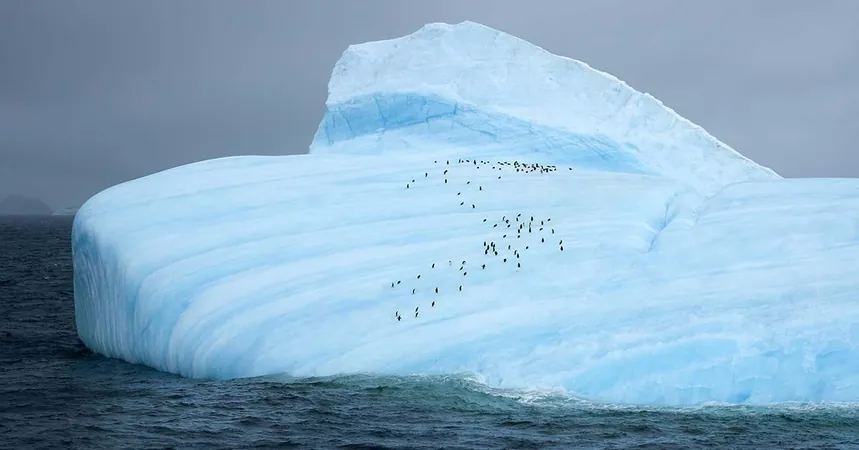
Unlocking the Secrets of the Deep: How Ocean Currents Shape Microbial Life in the South Pacific
2025-07-14
Author: Yu
Deep Dive Into Microbial Diversity
A revolutionary study published in *Science* reveals the profound impact of global overturning circulation on microbial life across the South Pacific. Conducted by leading scientists from the J. Craig Venter Institute, UC San Diego's Scripps Institution of Oceanography, and UC Berkeley, this research offers an unprecedented genetic map detailing how ocean currents mold these microscopic communities.
Currents as Ecosystems
The study, spearheaded by Bethany Kolody, indicates that while winds primarily influence surface waters, it's the deeper currents—driven by temperature and salinity differences—that create distinct microbial ecosystems below 500 meters (about 1,640 feet). Kolody confidently states, "We can now answer that question with a resounding, ‘yes,’" emphasizing the symbiotic relationship between water masses and microbial life.
Mapping Microbial Landscapes
Scientists gathered over 300 water samples ranging from Easter Island to Antarctica, employing cutting-edge metagenomic techniques. Their work not only reconstructed the genomes of over 300 types of microbes but also identified tens of thousands of additional species through advanced molecular fingerprinting.
The Mysteries of the Prokaryotic Phylocline
Their findings unveiled a remarkable pattern: microbial diversity spikes dramatically around 300 meters below the surface in a region dubbed the "prokaryotic phylocline." This area marks a striking transition from the nutrient-poor surface waters to the vibrant microbial ecosystems thriving in the dark depths.
Unique Microbial Cohorts Revealed
The research identified six unique microbial cohorts aligned with depth and major water masses, such as Antarctic Bottom Water and Upper Circumpolar Deep Water. Each cohort boasts distinct microbial species adapted to varying environmental conditions—cold, high-pressure zones or ancient waters devoid of sunlight for over a millennium.
Functional Insights Into Ocean Life
Beyond mapping species, researchers also explored the functional capabilities of these microbial communities, identifying ten “functional zones” based on key metabolic genes. These zones correspond to critical oceanographic features, revealing how these tiny organisms play vital roles in nutrient cycling and carbon sequestration.
Microbes: The Ocean's Hidden Architects
Microbes are the unsung heroes of the ocean's carbon cycle, converting carbon dioxide into organic compounds and helping trap carbon in the depths. This research is vital for understanding how climate change might disrupt these processes, signaling changes in the distribution and function of microbial communities.
A Call for Global Monitoring
Senior author Andrew Allen emphasizes that this study provides a crucial baseline for microbial ecosystems under current conditions. The findings spotlight the need for molecular sampling in global ocean monitoring efforts as climate shifts threaten these delicate ecosystems.
The Future of Marine Research
This interdisciplinary effort underscores the importance of collaboration among oceanographers and genome biologists in unraveling the complexities of ocean life. Supported by prestigious organizations, this groundbreaking research advocates for enhanced global monitoring to safeguard our planet’s largest ecosystem.
Conclusion: Understanding the Unknown
As Allen poignantly states, life in ocean ecosystems is governed by fundamental processes still shrouded in mystery. To grasp these intricacies, we must delve deeper and conduct meticulous studies, ensuring the survival of the vibrant microbial communities that underpin life in the oceans.


 Brasil (PT)
Brasil (PT)
 Canada (EN)
Canada (EN)
 Chile (ES)
Chile (ES)
 Česko (CS)
Česko (CS)
 대한민국 (KO)
대한민국 (KO)
 España (ES)
España (ES)
 France (FR)
France (FR)
 Hong Kong (EN)
Hong Kong (EN)
 Italia (IT)
Italia (IT)
 日本 (JA)
日本 (JA)
 Magyarország (HU)
Magyarország (HU)
 Norge (NO)
Norge (NO)
 Polska (PL)
Polska (PL)
 Schweiz (DE)
Schweiz (DE)
 Singapore (EN)
Singapore (EN)
 Sverige (SV)
Sverige (SV)
 Suomi (FI)
Suomi (FI)
 Türkiye (TR)
Türkiye (TR)
 الإمارات العربية المتحدة (AR)
الإمارات العربية المتحدة (AR)